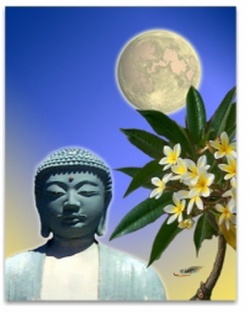Sankassa
Sankassa: A city, thirty leagues from Sāvatthi. (DhA.iii.224).
It was there that the Buddha returned to earth, after preaching the Abhidhamma Pitaka in Tāvatimsa, following the performance of the Twin Miracle under the Gandamba tree. As the time approached for the Buddha to leave Tāvatimsa , Moggallāna (Anuruddha, according to SNA.ii.570; cf. Vsm., p.391) announced his coming return to the multitude, who had been waiting at Sāvatthi, fed by Culla Anāthapindika, while Moggallāna expounded the Dhamma. They then made their way to Sankassa.
The descent of the Buddha took place on the day of the Mahāpavārana festival. Sakka provides three ladders for the Buddha's descent from Sineru. to the earth: on the right was a ladder of gold for the gods; on the left a silver ladder for Mahā Brahmā and his retinue; and in the middle a ladder of jewels for the Buddha. The assembled people covered the earth for thirty leagues round. There was a clear view of the nine Brahma worlds above and of Avīci below. The Buddha was accompanied by Pañcasikha, Mātali, Mahā Brahmā and Suyāma. Sāriputta was the first to welcome him (followed by Uppalavannā, SNA.ii.570), and the Buddha preached the Law, starting with what was within the comprehension even of a puthujjana, and ending with what only a Buddha could understand.
On this occasion was preached the Parosahassa Jātaka to proclaim to the multitude the unparalleled wisdom of Sāriputta (DhA.iii.224ff.; see also SNA.ii.570). It is said' that the Buddha's descent to Sankassa had provided opportunity for Moggallāna to show his eminence in iddhi, Anuruddha in dibbacakkhu, and Punna in skill in preaching, and the Buddha wished to give Sāriputta a chance of shining in his wisdom. (Ibid., loc. cit.; J.iv.266; see also Jhānasodhana, Sarabhamiga, and Candābha Jātakas). He therefore asked of Sāriputta questions which no one else could answer. The opening words of the Sāriputta Sutta are supposed to refer to this descent from Tusita (sic).
The site of the city gate of Sankassa is one of the "unchangeable" spots of the world (avijahitatthānam). All Buddhas descend at that spot to the world of men after preaching the Abhidhamma (BuA.106, 247; MA.i.371, etc.). From Sankassa the Buddha went to Jetavana (J.i.193).
A shrine was erected on the spot where the Buddha's right foot first touched the ground at Sankassa (DhA.iii.227). When the Chinese pilgrims, Hiouen Thsang and Fa Hien, visited the place, they found three ladders, which had been built of brick and stone by the ancients, to commemorate the Buddha's descent, but the ladders were nearly sunk in the earth. (Beal, op. cit., i.203; Fa Hien, p.24).
There was, in the Buddha's time, a deer park at Sankassa where Suhemanta Thera heard the Buddha preach (ThagA.i.212). During the Vajjiputta controversy, Revata Thera, on his way from Soreyya to Sahājāti, went through Sankassa. The road he took passed through Sankassa, Kannakujja, Udumbarā and Aggālapura (Vin.ii.299f).
Sankassa is now identified with Sankissa Basantapura on the north bank of the Ikkhumatī (Kālīnadī), between Atranji and Kanoj, twenty-three miles west of Fatehgarh and forty five north of Kanoj.
